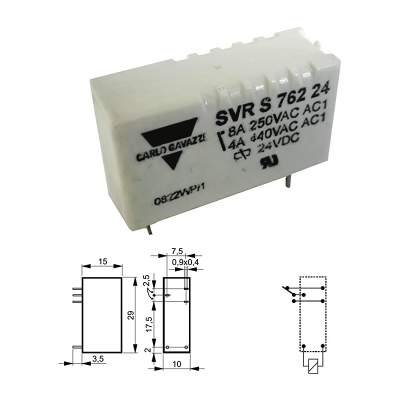No products in the cart.
Relay 8pin (24VDC – 5A) (SMI-24VDC-SL-2C)
In Stock
In Stock
Add to WishlistRemove from Wishlist
CompareAdd to Wishlist
Description
A Relay 8-pin (24VDC / 5A) is a general-purpose electromagnetic relay designed to switch high-power circuits (up to 5A) while being controlled by a lower power, low-voltage signal. It’s commonly used in control systems, automotive applications, home automation, and industrial machinery.
Here’s an overview of the Relay 8-pin (24VDC / 5A):
Relay 8-Pin (24VDC / 5A) Overview:
- Relay Type: Electromagnetic Relay with 8 pins.
- Coil Voltage: 24V DC (Direct Current).
- Switching Current: 5A maximum at 120V AC or 30V DC.
- Pin Configuration: Standard 8-pin configuration for controlling multiple connections.
Key Features:
- Coil Voltage:
- The relay has a coil voltage of 24V DC, meaning that it requires 24V DC to energize the coil and activate the switching mechanism inside the relay.
- Contact Rating:
- The relay can handle a switching current of up to 5A. This makes it suitable for controlling medium-power devices such as motors, lamps, or HVAC systems. The current rating may vary depending on the specific model and whether the relay is used for AC or DC circuits.
- Typically, the relay can switch 5A for AC loads (120V or 250V AC) or DC loads (24V DC).
- 8-Pin Configuration:
- 8 pins provide flexibility for different switching functions. Usually, the pins are arranged as follows:
- Pins 1, 2, 3: Coil pins (for energizing the relay).
- Pins 4, 5, 6, 7: Common, Normally Open (NO), Normally Closed (NC), and another common or NO pin for multi-contact relays.
- Pin 8: Some relays may have a common pin or a NO/NC pin, depending on the specific design.
- 8 pins provide flexibility for different switching functions. Usually, the pins are arranged as follows:
- Operating Voltage:
- 24V DC power is typically used in applications such as industrial automation, automotive circuits, and home appliances.
- Contact Configuration:
- SPDT (Single Pole Double Throw) or DPDT (Double Pole Double Throw) depending on the relay’s design. The most common configuration in 8-pin relays is SPDT, where you have one common pin, one Normally Open (NO) pin, and one Normally Closed (NC) pin.
- Switching Speed:
- Relays generally have slower switching speeds compared to solid-state relays, but they can switch heavier loads, and their design allows them to handle higher currents and voltages.
Applications:
- Automotive Applications: Used in automotive circuits to control high-current devices like lights, motors, and other equipment.
- Industrial Automation: Employed in control systems to activate/deactivate machinery, alarms, and other industrial devices.
- Home Appliances: Common in washing machines, refrigerators, and other home appliances to switch on/off high-power components.
- Home Automation: Can be used in smart home systems for switching lights, fans, and other high-power appliances.
- Control Circuits: Often used in temperature control circuits, HVAC systems, and safety systems.
- Power Distribution: Used in power distribution systems to control the flow of electricity to different parts of the circuit.
Specifications:
| Specification | Relay 8-pin (24VDC / 5A) |
|---|---|
| Coil Voltage | 24V DC |
| Switching Current | 5A |
| Contact Configuration | SPDT (Single Pole Double Throw) or DPDT |
| Coil Resistance | Typically 450Ω |
| Coil Power Consumption | Around 0.5W to 1W |
| Max Switching Voltage | 120V AC / 30V DC |
| Contact Type | Normally Open (NO) / Normally Closed (NC) |
| Mounting | PCB (Printed Circuit Board) mountable or socketed |
Advantages:
- High Load Capacity: The 5A current rating allows it to switch high-power loads effectively.
- Reliability: Electro-mechanical relays like this have a long lifespan when used within their rated capacity.
- Versatility: The 8-pin configuration provides flexibility for various applications, such as switching multiple contacts or controlling both AC and DC circuits.
- Electromagnetic Actuation: Traditional relays like this are reliable in noisy environments since they are purely mechanical and immune to electromagnetic interference (EMI) in comparison to solid-state relays.
Disadvantages:
- Slower Switching Speed: Mechanical relays are slower compared to solid-state relays and may not be suitable for high-speed switching applications.
- Mechanical Wear: Over time, the mechanical contacts may wear out due to repeated switching, especially at high current ratings.
- Noise: These relays can generate a clicking noise when they switch, which may be undesirable in certain quiet environments or applications.
How to Use the 8-Pin (24VDC / 5A) Relay:
- Coil Connections:
- Pins 1 and 2 (or 1 and 3) are typically used to connect the coil. These pins are used to energize the relay by applying the 24V DC to switch it on and off.
- Switching Contacts:
- Pin 4 is generally the common (COM) pin, while pin 5 is the Normally Open (NO) and pin 6 is the Normally Closed (NC) pin.
- The NO pin will be connected to the COM pin when the relay is energized, whereas the NC pin is connected to the COM pin when the relay is not energized.
- Power and Load Connections:
- Pins 7 and 8 are usually used for additional contacts, if the relay is designed as DPDT (double-pole, double-throw), providing more switching options for the load.
- Controlling the Relay:
- To activate the relay, you apply 24V DC to the coil pins (usually 1 and 2). When the coil is energized, the internal contacts will switch to connect the NO pin with the COM pin. When the coil is de-energized, the relay switches back to the NC configuration.
Dimensions:
Only logged in customers who have purchased this product may leave a review.
- Image
- SKU
- Rating
- Price
- Stock
- Availability
- Add to cart
- Description
- Content
- Weight
- Dimensions
- Additional information









Reviews
There are no reviews yet.